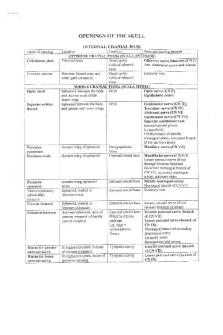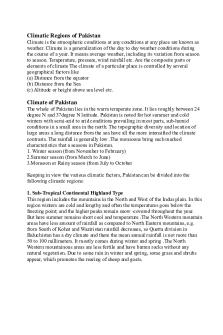Manual - Lab 1 (Skull and regions of H&N) PDF

| Title | Manual - Lab 1 (Skull and regions of H&N) |
|---|---|
| Course | Human Structure And Function |
| Institution | University of Western Australia |
| Pages | 12 |
| File Size | 710.4 KB |
| File Type | |
| Total Downloads | 82 |
| Total Views | 139 |
Summary
Download Manual - Lab 1 (Skull and regions of H&N) PDF
Description
3324 LABORATORY SESSION: The Skull and Regions of the Head and Neck
Acknowledgements We would like to thank Nick Milne for the use of his materials in this manual and also to acknowledge the additional materials provided by John McGeachie. Both wonderful teachers and members of the School of Anatomy for many decades.
Version 1.0 (September 2019)
Version 1.0 – Manual 3324 – The Skull
2
Osteology of the Skull Work in pairs to examine a skull. The skull consists of a cranium and a mandible. The cranium can be thought of as having two major parts: The brain case enclosing and protecting the brain, and the facial skeleton. You will notice that, while the brain case is composed of fairly strong and thick bone, the parts of the facial skeleton are paper thin. For this reason great care must be taken when handling the skulls - NEVER HOLD THE SKULL BY THE EYE SOCKETS OR NASAL CAVITY. The safest way to handle a skull is which a finger in the foramen magnum. The skull is normally described from its anterior, superior, posterior, lateral, inferior and internal aspects (those features which you may be able to palpate are underlined). There is a lot of information on the following pages. Do not try to memorise everything this week. Over the following weeks you should return to these pages to consolidate and complete your understanding of the Osteology of the skull NORMA VERTICALIS Examine a skull from the superior aspect. As you work through the list of features on the skull, try to identify the structures on your own head or that of a partner. Draw and label the following features on the outline Frontal bone Coronal suture Bregma (anterior fontanelle in infants)
Parietal bones Sagittal suture Parietal foramen Occipital bone (just visible posteriorly) Lambda Lambdoid suture
NORMA OCCIPPITALIS Examine a skull from the posterior aspect. As you work through the list of features on the skull, try to identify the structures on your own head or that of a partner. Draw the posterior aspect of the skull and label the following features. Parietal bones Occipital bone Lambdoid suture and lambda Nuchal lines (what muscles attach here?) External occipital protuberance (the inion) Occipital condyles (for articulation with the vertebral column) Temporal bone Mastoid process
Version 1.0 – Manual 3324 – The Skull
3
NORMA FRONTALIS Examine a skull from the anterior aspect. As you work through the list of features on the skull, try to identify the structures on your own head or that of a partner. Label extra features on the diagram of the norma frontalis. Orbits Nares Frontal bone: (forms the forehead and the roofs of the orbits) Supraorbital foramen or notch (which do you have?) Glabella (prominence of bone just above the bridge of the nose) Superciliary ridges (prominences underlying the eyebrows) Nasal bones: Feel the difference between the bony and cartilagenous parts of your own nose Lachrymal bone has the naso-lachrymal canal on the medial side of the orbits Zygomatic bone: These form your cheek bones: Temporal process (forms the anterior part of the zygomatic arch). Orbital margin (around the edge of the orbit the zygomatic bone joins the frontal bone laterally, and the maxilla along the lower margin of the orbit) Maxilla Forms the lower medial part of the orbital margin and articulates with the frontal bone medially Forms most of the margin of the nares Anterior nasal spine Infraorbital foramen Alveolar process: forms the upper jaw and holds all the upper teeth
Version 1.0 – Manual 3324 – The Skull Maxillary sinus (large air space situated in the bone above the upper teeth) Palatine process (forms most of the roof of the mouth)
Mandible Mental protuberance (chin) Mental foramen Body of mandible Genial tubercles Mylohyoid line Submandibular fossa Angle of mandible The regions of the head seen in the frontal view include: 1. Scalp 2. Face 3. Nose 4. Orbits 5. Mouth 6. Temporal region
4
Version 1.0 – Manual 3324 – The Skull
5
NORMA LATERALIS Examine a skull from the lateral aspect. As you work through the list of features on the skull, try to identify the structures on your own head or that of a partner. Label extra features on the diagram of the norma lateralis. Parietal bone Temporal lines and Temporal fossa
Occipital bone Frontal bone Coronal suture Pterion (junction of frontal, parietal, temporal and sphenoid bones) Notice how thin the bone is in this region What muscle covers this area? Temporal bone Squamous part Petrous part Mastoid process Styloid process Tympanic plate External acoustic meatus Zygoma (zygomatic process of temporal bone) Temporomandibular joint (Mandibular fossa) (Articular eminence) Sphenoid Bone Greater wing Pterygoid plates Pterygomaxillary fissure Maxilla Alveolar process Nares Maxillary sinus Zygomatic bone Orbital margin Mandible Angle Body Ramus Coronoid process Condyloid process (head of mandible)
The regions of the head seen in the lateral view include all those seen from the front plus:
Version 1.0 – Manual 3324 – The Skull 1. Parotid region 2. Nuchal region Locate each region on the skull, and an X-ray and mark them on the diagram….
6
Version 1.0 – Manual 3324 – The Skull
7
NORMA BASALIS The main features on the inferior aspect of the skull are the palate the choana (posterior nasal aperture), the foramen magnum and other foramina on the base of the skull. Occipital bone Foramen magnum Squamous part Basiocciput Occipital condyles Jugular foramen Hypoglossal canal Temporal bone Petrous part Tympanic part Zygoma Styloid process Mastoid process Stylomastoid foramen Carotid canal Sphenoid bone Greater wing Foramen ovale For. spinosum Foramen lacerum Pterygoid plates Pterygoid hamulus (2 small hooks of bone at the back of the hard palate)
Palatine bone Posterior part of the palate Greater and lesser palatine foramina Maxilla Palatine plates Dental arch of the alveolar processes Incisive canal
Version 1.0 – Manual 3324 – The Skull
8
INSIDE THE CRANIAL CAVITY The floor of the cranial cavity is divided into three levels or cranial fossae: 1. Anterior cranial fossa Orbital plates of the frontal bone Ethmoid bone Cribriform plate Crista galli Lesser wings of the sphenoid bone 2. Middle cranial fossa Sphenoid bone Body of sphenoid Pituitary fossa (sella turcica) Dorsum sellae Tuberculum sellae Anterior clinoid processes Posterior clinoid processes Greater wing of the sphenoid bone Foramen rotundum Foramen ovale Foramen spinosum Foramen lacerum Carotid canal Temporal bone Petrous temporal (middle and inner ear) 3. Posterior cranial fossa Occipital bone Clivus = Basiocciput + basisphenoid Squamous part of occipital bone Foramen magnum Hypoglossal canal Temporal bone Internal acoustic meatus
Look at a lateral and an anterior X-ray of the skull – You should be able to find all the underlined features Look some CT scans as well – see how many features and regions you can identify
Version 1.0 – Manual 3324 – The Skull
9
Detailed Structure of specific bones – Appendix to the laboratory for review purposes. MAXILLA Articulations Other maxilla, zygomatic, palatine Ethmoid, lacrimal, frontal, nasal, vomer Lateral View
Medial View
Zygomatic process Facial surface Alveolar process Incisive fossa Canine fossa Canine eminence Anterior nasal spine Frontal process Naso-lacrimal groove
Alveolar process Palatine part Incisive canal Conchal crest Frontal process Sinus and hiatus Palatine articulations
Anterior View
Superior View
Zygomatic process Facial surface process
Orbital surface Infra-orbital groove and Alveolar canal Naso-lacrimal groove
Canine eminence Anterior nasal spine Frontal process Infra-orbital foramen Infra-orbital margin
Version 1.0 – Manual 3324 – The Skull
10
PALATINE BONE Articulations Maxilla, ethmoid, sphenoid Vomer, concha, other palatine Anterior View
Lateral View
Perpendicular plate Horizontal plate Pyramid Orbital process Spheno-palatine notch
Greater palatine groove Medial View Conchal crest
VOMER BONE Articulations Sphenoid Ethmoid Maxillae Septal cartilage: not shown in dry skulls because the cartilage is removed in the skull preparation. See the Atlas for details. Lateral View Ala Naso-palatine groove
LACRIMAL BONE (see the whole skull for this) Articulations Maxilla, concha, ethmoid Frontal Orbital surface Nasal surface Lacrimal fossa
Version 1.0 – Manual 3324 – The Skull
11
ZYGOMATIC BONE Articulations Maxilla, frontal, temporal Sphenoid Lateral View Orbital Border Zygomatico-facial Foramen
Medial View
Zygomatico-temporal foramen
MANDIBLE Lateral View
Medial View
Body and ramus Alveolar process Condyle Coronoid process Notch Angle External oblique ridge Mental protuberance Mental tubercles Head of condyle Mental foramen
Mandibular foramen Mylohyoid groove Mylohyoid ridge Submandibular fossa Sublingual fossa Superior and inferior genial tubercles (these have variable shapes) Pterygoid fovea-for attachment of the lateral pterygoid muscle
Muscle attachment markings Medial View
Lateral View
Digastric (anterior belly) Mylohoid Geniohyoid Mentalis Genioglossus Medial pterygoid Lateral pterygoid Temporalis
Masseter Buccinator Depressor labii inferior Depressor anguli oris Platysma
Ligamentous attachments Spheno-mandibular Stylo-mandibular Pterygo-mandibular raphe – there is no marking here but it attaches at the posterior end of the mylohyoid line.
Version 1.0 – Manual 3324 – The Skull
12...
Similar Free PDFs

Openings of the skull
- 5 Pages

Climatic Regions of Pakistan
- 2 Pages

Hominid Skull
- 3 Pages

Lab Manual of VLS
- 58 Pages

Group 1 HN-Gana-Jamlos
- 31 Pages

DLD LAB 1 - Lab manual
- 7 Pages

Skull and trunk notes- sheetal
- 74 Pages

Lab manual 1 MP systems and interfacing
- 106 Pages

Prac 1 Lab Manual
- 17 Pages

HN.-G4-1. Kokomi. Kokomi
- 22 Pages
Popular Institutions
- Tinajero National High School - Annex
- Politeknik Caltex Riau
- Yokohama City University
- SGT University
- University of Al-Qadisiyah
- Divine Word College of Vigan
- Techniek College Rotterdam
- Universidade de Santiago
- Universiti Teknologi MARA Cawangan Johor Kampus Pasir Gudang
- Poltekkes Kemenkes Yogyakarta
- Baguio City National High School
- Colegio san marcos
- preparatoria uno
- Centro de Bachillerato Tecnológico Industrial y de Servicios No. 107
- Dalian Maritime University
- Quang Trung Secondary School
- Colegio Tecnológico en Informática
- Corporación Regional de Educación Superior
- Grupo CEDVA
- Dar Al Uloom University
- Centro de Estudios Preuniversitarios de la Universidad Nacional de Ingeniería
- 上智大学
- Aakash International School, Nuna Majara
- San Felipe Neri Catholic School
- Kang Chiao International School - New Taipei City
- Misamis Occidental National High School
- Institución Educativa Escuela Normal Juan Ladrilleros
- Kolehiyo ng Pantukan
- Batanes State College
- Instituto Continental
- Sekolah Menengah Kejuruan Kesehatan Kaltara (Tarakan)
- Colegio de La Inmaculada Concepcion - Cebu





